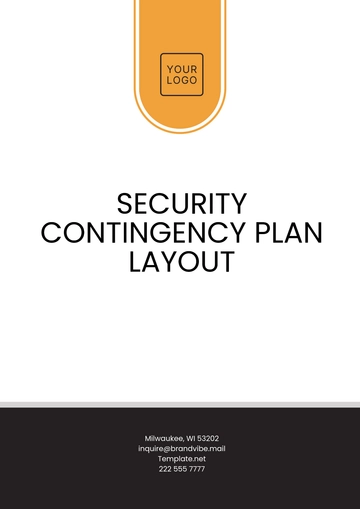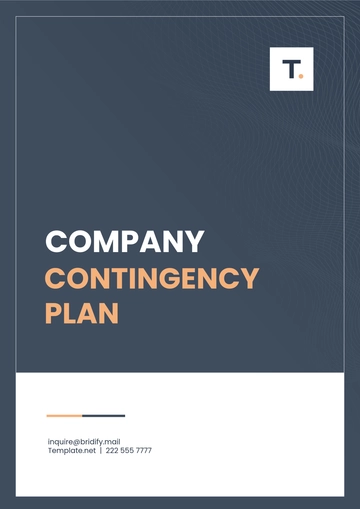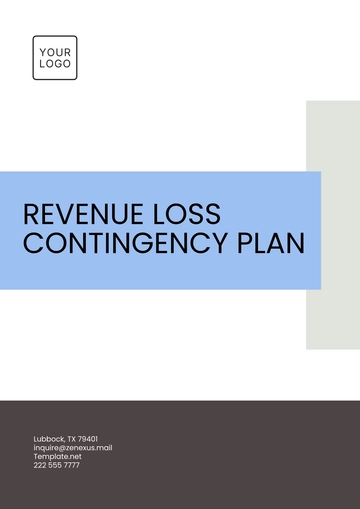Free Contingency Plan

Prepared By: [Your Name]
Date: June 18, 2060
I. Introduction
This Contingency Plan aims to guarantee that [Your Company Name] is fully equipped to respond to and alleviate the effects of unforeseen emergencies or disruptions. This detailed plan encompasses every operational aspect of our global infrastructure, ensuring that business activities can continue without interruption and that the interests of our stakeholders are protected.
II. Risk Assessment
The Risk Assessment section identifies potential risks and threats impacting our operations. These include:
Cybersecurity threats such as data breaches and ransomware attacks.
Natural disasters include floods, earthquakes, and hurricanes.
Supply chain disruptions due to geopolitical instability or pandemics.
Operational risks from equipment failures or power outages.
III. Roles and Responsibilities
Effective response requires clearly defined roles and responsibilities. The following assignments are made to ensure accountability:
Role | Name | Responsibilities |
|---|---|---|
Emergency Response Coordinator | Lyda Fadel | Overall command of incident response and coordination with emergency services. |
IT Security Lead | Johann Harvey | Safeguarding digital assets and restoring IT infrastructure. |
Logistics Manager | Sigmund Corwin | Managing supply chain continuity and resource allocation. |
Communications Director | Jolie Cassin | Leading all internal and external communications efforts. |
IV. Response Procedures
In the event of an emergency, the following response procedures should be followed:
Cybersecurity Breach: Immediately isolate affected systems, inform the IT Security Lead, and initiate incident response protocol.
Natural Disaster Evacuation: Follow facility evacuation plans, account for all employees, and secure critical assets.
Supply Chain Disruption: Activate alternative supplier contracts, optimize inventory levels, and communicate changes to stakeholders.
V. Communication Plan
Effective communication is crucial during a crisis. The steps for communication include:
Internal Notices: When a crisis is identified, notifications will promptly be sent to all employees via email and the company's intranet.
External Updates: Press releases and social media postings by the Communications Director as needed.
Stakeholder Briefings: Regular updates are shared with investors and partners to maintain transparency.
VI. Resource Management
Resource management ensures that necessary resources are available for both response and recovery:
Emergency Supplies: Maintain a stock of emergency supplies including food, water, and medical kits at all sites.
Technology and Tools: Ensure backups and redundant systems are operational; verify software licenses and subscriptions.
Financial Resources: Set aside a specific amount of money as an emergency fund to be used exclusively for covering unexpected or unplanned expenses that may arise in the future.
VII. Recovery Procedures
The recovery procedures outline the steps to return to normal operations post-crisis:
System Restoration: The IT department will restore data from backups and then verify system integrity and accuracy.
Facility Assessments: Conduct safety inspections and repairs to physical infrastructure as needed.
Staff Reintegration: Gradually phase employees back into regular work schedules with support programs.
VIII. Review and Testing
To ensure the plan remains effective, regular review and testing are required:
Carry out a yearly assessment of our plan to improve and adjust the procedures, integrating insights from previous experiences and tackling any newly discovered risks.
Conduct quarterly tabletop exercises designed to simulate various scenarios to thoroughly test and evaluate our response capabilities.
Feedback Mechanisms through employee surveys to identify gaps in the plan and implement improvements.
- 100% Customizable, free editor
- Access 1 Million+ Templates, photo’s & graphics
- Download or share as a template
- Click and replace photos, graphics, text, backgrounds
- Resize, crop, AI write & more
- Access advanced editor
Prepare for unexpected challenges with this professionally crafted Contingency Plan Template. Ideal for businesses and organizations, this template ensures you remain proactive and resilient. Fully editable and customizable, it helps you outline crucial steps to mitigate risks effectively. Editable in our Ai Editor Tool at Template.net, this template simplifies your planning process, ensuring every detail aligns with your needs.
You may also like
- Finance Plan
- Construction Plan
- Sales Plan
- Development Plan
- Career Plan
- Budget Plan
- HR Plan
- Education Plan
- Transition Plan
- Work Plan
- Training Plan
- Communication Plan
- Operation Plan
- Health And Safety Plan
- Strategy Plan
- Professional Development Plan
- Advertising Plan
- Risk Management Plan
- Restaurant Plan
- School Plan
- Nursing Home Patient Care Plan
- Nursing Care Plan
- Plan Event
- Startup Plan
- Social Media Plan
- Staffing Plan
- Annual Plan
- Content Plan
- Payment Plan
- Implementation Plan
- Hotel Plan
- Workout Plan
- Accounting Plan
- Campaign Plan
- Essay Plan
- 30 60 90 Day Plan
- Research Plan
- Recruitment Plan
- 90 Day Plan
- Quarterly Plan
- Emergency Plan
- 5 Year Plan
- Gym Plan
- Personal Plan
- IT and Software Plan
- Treatment Plan
- Real Estate Plan
- Law Firm Plan
- Healthcare Plan
- Improvement Plan
- Media Plan
- 5 Year Business Plan
- Learning Plan
- Marketing Campaign Plan
- Travel Agency Plan
- Cleaning Services Plan
- Interior Design Plan
- Performance Plan
- PR Plan
- Birth Plan
- Life Plan
- SEO Plan
- Disaster Recovery Plan
- Continuity Plan
- Launch Plan
- Legal Plan
- Behavior Plan
- Performance Improvement Plan
- Salon Plan
- Security Plan
- Security Management Plan
- Employee Development Plan
- Quality Plan
- Service Improvement Plan
- Growth Plan
- Incident Response Plan
- Basketball Plan
- Emergency Action Plan
- Product Launch Plan
- Spa Plan
- Employee Training Plan
- Data Analysis Plan
- Employee Action Plan
- Territory Plan
- Audit Plan
- Classroom Plan
- Activity Plan
- Parenting Plan
- Care Plan
- Project Execution Plan
- Exercise Plan
- Internship Plan
- Software Development Plan
- Continuous Improvement Plan
- Leave Plan
- 90 Day Sales Plan
- Advertising Agency Plan
- Employee Transition Plan
- Smart Action Plan
- Workplace Safety Plan
- Behavior Change Plan
- Contingency Plan
- Continuity of Operations Plan
- Health Plan
- Quality Control Plan
- Self Plan
- Sports Development Plan
- Change Management Plan
- Ecommerce Plan
- Personal Financial Plan
- Process Improvement Plan
- 30-60-90 Day Sales Plan
- Crisis Management Plan
- Engagement Plan
- Execution Plan
- Pandemic Plan
- Quality Assurance Plan
- Service Continuity Plan
- Agile Project Plan
- Fundraising Plan
- Job Transition Plan
- Asset Maintenance Plan
- Maintenance Plan
- Software Test Plan
- Staff Training and Development Plan
- 3 Year Plan
- Brand Activation Plan
- Release Plan
- Resource Plan
- Risk Mitigation Plan
- Teacher Plan
- 30 60 90 Day Plan for New Manager
- Food Safety Plan
- Food Truck Plan
- Hiring Plan
- Quality Management Plan
- Wellness Plan
- Behavior Intervention Plan
- Bonus Plan
- Investment Plan
- Maternity Leave Plan
- Pandemic Response Plan
- Succession Planning
- Coaching Plan
- Configuration Management Plan
- Remote Work Plan
- Self Care Plan
- Teaching Plan
- 100-Day Plan
- HACCP Plan
- Student Plan
- Sustainability Plan
- 30 60 90 Day Plan for Interview
- Access Plan
- Site Specific Safety Plan





























